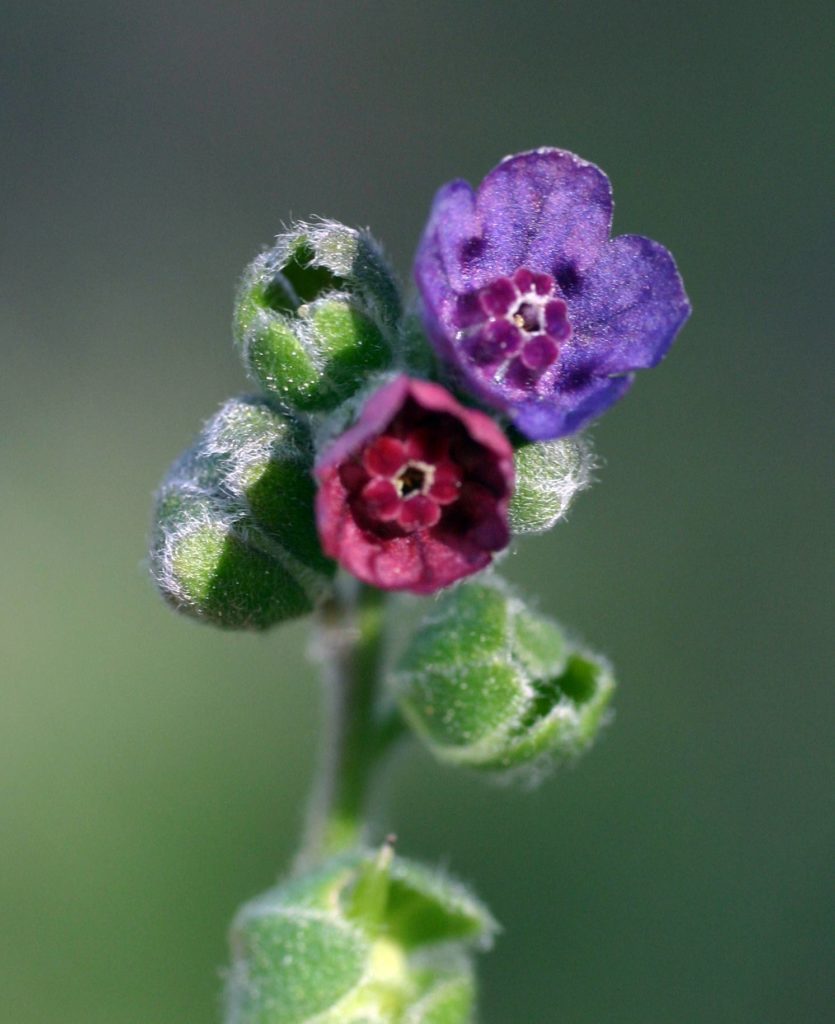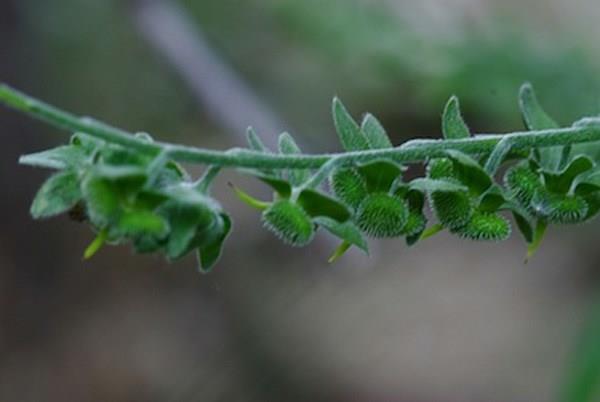Scientific name: Cynoglossum officinale
Common names: houndstongue, beggar’s lice, dog’s tongue, sheep bur, dog bur, glovewort, wool mat, gypsy-flower
Family: Boraginaceae
Article by Jeanne Gozigian
I still remember how excited we, the docents at the Leonora Curtin Wetland Preserve (LCWP), all were when the intrepid docent/plant detective team of Helen Woody and the late Janice Tucker discovered a “new” plant at the Preserve. LCWP was a part of the Santa Fe Botanical Garden in Santa Fe, New Mexico. As Susan Bruneni, the former staff at LCWP has said, “the discovery of a new plant here is like the discovery of a new planet!” The team determined that the plant, newly seen at LCWP, was Cynoglossm officinale, commonly called, houndstongue.

Photo by Paul Rothrock. SEINet Portal Network. 2022.
Houndstongue is a biennial. The first season after seed germination sees a dull green, hairy basal rosette of houndstongue shaped leaves, hence the name, about 4 to 12 inches (10-30 cm) long and 0.8 to 2 inches (2-5 cm) wide.

Cynoglossum officinale by Janice Tucker.
The second season produces a 2-4 foot stem with alternate, petiolate then sessile, leaves. Reddish-purple blossoms appear at the tips of the stems; 5 triangular sepals fuse to form a star-shaped calyx, a funnel-shaped corolla with 5 petals.
Rather a handsome plant, we all thought! Names are always interesting to “plant nuts”. Lynos, from the Greek, means, dog and glossce, means, tongue. Officinale refers to the fact houndstongue was sold as a medicinal herb that was sold in “offices” – apothecaries or pharmacies.
Imagine my horror when, doing further research on Cynoglossum officinale, I discovered that this exciting new plant was both highly toxic and invasive. Like many plants of this type, originating in montane zones of Western Asia and Eastern Europe, it is thought to have arrived here as a contaminant in grains. Now, it is present in every state of the USA and province of Canada, at low and high altitudes, thriving in every kind of soil, as at LCWP, where it appears in riparian zones.
When houndstongue goes to seed, four prickly nutlets are formed. These nutlets can catch on clothing or animal’s pelts, spreading the seeds.

Stem and flowers after the bloom. Photo by Janice Tucker.
The poisonous nature of this plant is the presence of pyrrollzidine, an alkalant. It is a good thing that animals no longer graze at LCWP, once a part of the historic El Rancho de las Golondrinas. Cattle and horses that ingest it develop fibrosis of the liver; weight loss and failure follow, nervous system damage causes bizarre symptoms like excessive yawning and staggering in circles. Exposed skin areas become red and swollen, die, then slough off like a burn. Jaundice, diarrhea, rectal prolapse and edema of the legs happen. There is no treatment. Death results. Sheep seem to be less susceptible. The Guide to Poisonous Plants deems Cynoglossum officinale to be extremely dangerous and noxious, one of the most poisonous plants to animals.
When found in grazing lands, it should be cut before going to seed, but, ideally, pulled out by the roots. Our love affair with hound’s tongue is over!
Sources:
Cynoglossum officinale
Colorado Rocky Mountain Wildflowers
retrieved: Nov. 14, 2021
www.swcoloradowildlowers.com
Common Hound’s -Tongue, Montana Field Guide
retrieved: Nov. 7, 2021
fieldguide.mt.gov
Cynoglossum officinale, hound’s tongue
Plant Database
retrieved: Nov. 7, 2021
sfbotanicalgarden.org
Guide to Poisonous Plants- College of Veterinary Medicine
retrieved: Nov. 7, 2021
csuvth.colostate.edu-poisonous_plants-plants
Houndstongue Noxious Weed -Poisonous and Toxic
retrieved: Nov. 2, 2021
www.treesandweeds.com-houndstongue-noxious_weed
Sanders, Jack, The Secrets of Wildflowers
Lyons Press, Guilford, CT, 2003
SEINet Portal Network. 2022. http//:swbiodiversity.org/seinet/index.php. Accessed on May 25.
Witson, Tom, et.al., Weeds of the West,
University of Wyoming
5th edition, 1996


